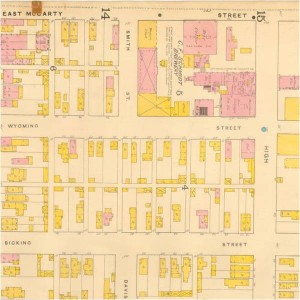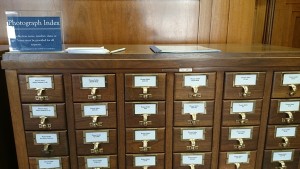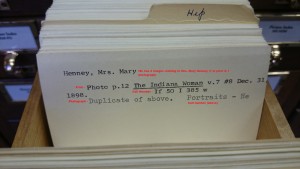Upon first glance of the spine, this little book appears fairly nondescript and boring. The book in question, “Discipline of the Yearly Meeting of Friends, Held in New York […] 1810”, printed by Samuel Wood & Sons, New York, 1826, has been digitized and is freely available on Google Books (though it is the 1836 edition). “So why bother with conservation treatment?” one might ask.
Category Archives: Rare Books & Manuscripts
A One-on-One Conversation with Brittany Kropf
I recently had a conversation with our new Rare Books & Manuscripts Librarian Brittany Kropf. Brittany recently started working at the Indiana State Library full-time and was an intern here while she studied at IUPUI in the Master of Library Science program. The following is an excerpt from our interview.
 RB: Please give a brief description of what your job is at the library…
RB: Please give a brief description of what your job is at the library…
BK: I work a lot with the Rare Books and Manuscripts collection, processing and getting them ready for patrons to access. Eventually we will be getting more collections, so I will be working with donors and any events that we need to do. Also, I’ll be helping digitize a lot of our collections. Part of my job is going to be working with the state-wide services side – Indiana Memory – and be the liaison between them and the public services. We will put together work flows and standardized procedures so that we can get materials digitized for the future. Continue reading
Cuneiform Tablets
The Rare Books and Manuscripts Division is often asked, “What is the earliest item in your collection?” Believe it or not, the earliest items are cuneiform (kyoo-nee’-uh-form) tablets ranging from 2350-2000BC. The tablets were purchased from Edgar J. Banks, antiquarian and archaeologist, on April 25, 1927 for a total of $24.00.
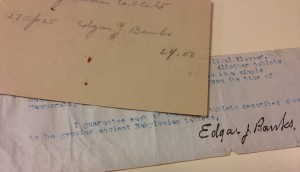
Did you know cuneiform script is one of the earliest known systems of writing? Developed in Mesopotamia around 3500-3000BC, a stylus or scribe pressed into soft clay to produce wedge impressions, called pictographs or phonograms. The library’s cuneiform tablets include simplified, wedge-based strokes with word concepts, rather than signs. They were found in southern Mesopotamia (modern day southern Iraq) and created by the ancient civilization of Sumer.
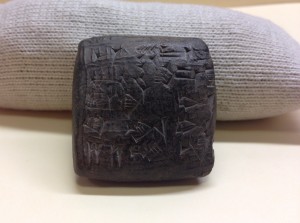
Above: Found at Umma (Jokha), this is a typical temple record of offerings from around 2350BC. After the tablet was written (while the clay was still soft), the temple scribe rolled over his cylindrical stone seal, making it impossible to change the record. The seal impression confirms the scribe’s signature and other important figures.
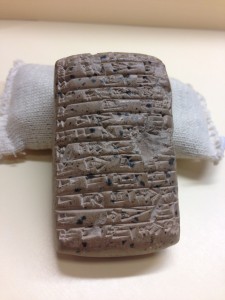
Above: Found at Umma (Jokha), this is a large tablet containing a long list of produce, probably a tax list. The date is approximately 2350BC. The tablet comes from the early part of the Ur Dynasty of Kings who ruled Babylonia from about 2400-2100BC.
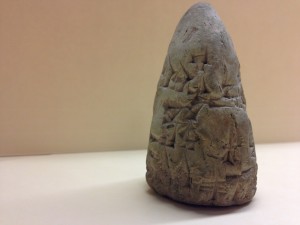
Above: Found at Uruk (Warka), this is a votive cone, made by the priests of the Temple of Ishtar, the Goddess of Love. The inscription reads, “For Sin-ga-shid, the mighty hero, King of Erech, King of Amanu, in the temple of the Goddess Ishtar which he built in the royal residence of his kingdom.” The date of this king, and therefore of the cone, is about 2100BC.

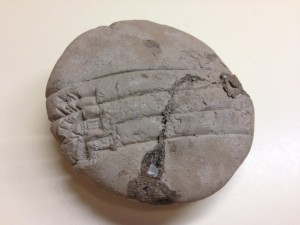
Above: Found at Uruk (Warka), this is a very rare school exercise tablet. These tablets are always this shape, round, nearly flat on one side and convex on the other. The teacher wrote the exercise on the convex side (left) and the boy copied it on the other side (right). The inscription has no meaning, being words for the practice of writing, dating from around 2000BC.
This blog post was written by Bethany Fiechter, Rare Books and Manuscripts Supervisor, Indiana State Library. For more information, contact the Rare Books and Manuscripts Division at (317) 232-3671 or “Ask-A-Librarian” at http://www.in.gov/library/ask.htm.
Indianapolis Brewing Company Digital Collection
The Indiana State Library is proud to announce the newest digital collection available through Indiana Memory, the Indianapolis Brewing Company photograph album. The collection contains 66 photographs of the C. F. Schmidt brewing plant, one of three plants owned by the Indianapolis Brewing Company. The photographs, taken sometime in the early twentieth century, depict the exterior and interior of the brewing plant, and also includes several photographs of brewing equipment. The brewery was located at the corner of McCarty and High St. where the present day Lilly Corporate Center is located.
The original brewing plant was founded by Christian Frederick Schmidt and Charles Jaeger in 1858. The duo owned and operated the brewery until 1889, when the plant merged with two other local brewing plants to form the Indianapolis Brewing Company. The Schmidt brewery brands included a Bock, Budweiser, Cream Ale, Dublin Porter, Stock Ale, and Tonica. The brewery grew in popularity for their ability to produce a bottom-fermented lager that closer resembled European beers more familiar to Hoosiers than the strong ales made from baking yeast that was common for the period.
The Indianapolis Brewing Company, founded in 1887, was the largest Indiana based brewery. The brewery was comprised of three separate brewing plants, the P. Lieber Brewing Company City Brewery, the Casper Maus Brewery, and the C.F. Schmidt Brewing Company. The Indianapolis Brewing Company won medals for its Duesseldorfer beer at the Paris Exposition of 1900, the St. Louis World’s Fair in 1904, and at Liege, Belgium in 1906. In 1918, the state of Indiana instituted Prohibition, forcing the Indianapolis Brewing Company to begin producing non-alcoholic beverages and tonics. The C.F. Schmidt plant of the Indianapolis Brewing Company ceased operations May 27, 1920, after 70 years of brewing.
Be sure to continually visit Indiana Memory, http://digital.library.in.gov, to find the latest digital collections published by the Indiana State Library. The Indiana State Library, through Indiana Memory, continues to produce digital collections highlighting the library’s rich and varied collections. The Indianapolis Brewing Company photograph collection is located within the Indiana State Library Rare Books and Manuscripts Division Photograph Collections, http://cdm16066.contentdm.oclc.org/cdm/landingpage/collection/p16066coll13. Take a minute to enjoy a unique behind the scenes view of a pre-Prohibition era brewery!
This blog post was written by Brent Abercrombie, Rare Books & Manuscripts Librarian, Indiana State Library. For more information, contact the Indiana State Library at (317)232-3678 or “Ask-A-Librarian” at http://www.in.gov/library/ask.htm.
Have you visited the Rare Books and Manuscripts Division lately?
Have you visited the Rare Books and Manuscripts Division lately? If not, you’ll want to see our beautiful, new reading room located on the 2nd floor. When you arrive, check in with the Circulation, Reference, or Indiana Desk to call for staff from the Division. We’ll be sure to help you navigate our research tools and answer any specific questions.

While you’re here, be sure to utilize our new DaVinci HD Desktop Magnifier, too. This document camera has the ability to zoom in/out and create contrast to analog material, digitally. The Indiana State Library is the only reading room in Indiana to have this equipment available to patrons.
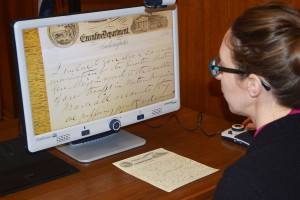
Don’t worry; the card catalogs are still available for your perusal. In fact, we continue to update them on a daily basis. We’ve also added a set of the library’s original benches by our printed finding aids. We hope you love them as much as we do!

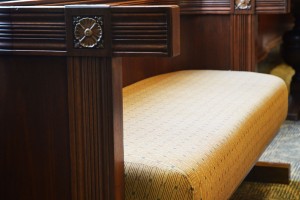
If you can’t make it in, we have detailed instructions available at your fingertips. Please visit our “Research Tools” page, here: http://www.in.gov/library/5100.htm.
This blog post was written by Bethany Fiechter, Rare Books and Manuscripts Supervisor, Indiana State Library. For more information, contact the Rare Books and Manuscripts Division at (317) 232-3671 or “Ask-A-Librarian” at http://www.in.gov/library/ask.htm.
Researching the Photograph Collection
Staff of the Rare Books and Manuscripts division recently finished re-processing its Photograph Collection and updated guide. The 93 box collection includes images from all 92 counties and is organized alphabetically by location or subject. The Photograph Collection was originally located in the old Manuscripts Reading Room. The natural light and fluctuating temperatures in the room were harmful to the photographs necessitating its move to the library’s temperature and climate controlled vault.

Since most of the library’s photographs are not cataloged, researching them can be a little tricky. The general Photograph Collection contains the bulk of the library’s photographs, but we also have specific photograph collections that include a name and call number. Most of these smaller photograph collections include a finding aid (or guide) that provides more specific information. Rare Books and Manuscripts finding aids are all located on the library’s Finding Aid Index page. Staff and patrons still rely on the Photograph Index cards for locating specific information about a particular image.
The Photograph Index cards contain information about individual images found in both the library’s picture collections and in our printed material (i.e. books, pamphlets, etc.). The cards contain information that helps librarians retrieve the item. For images identified in the Photograph Index, the card will contain a location (Benton County) or subject term (Churches). The Photograph Collection also includes many portraits, which are organized by the subject term Portraits and then alphabetically by the individual’s last name. For images located in printed material, the card will contain the call number, title, and page number for the image.
Moving forward, ISL plans to digitize portions of the Photograph Collection, as well as some specific photograph collections, to upload into Indiana Memory. During the processing of the Photograph Collection, staff identified certain aspects of the collection to be digitized in the future. Stay tuned for updates regarding when these collections are available through Indiana Memory.
This blog post was written by Brent Abercrombie, Rare Books & Manuscripts Librarian, Indiana State Library. For more information, contact the Indiana State Library at (317)232-3678 or “Ask-A-Librarian” at http://www.in.gov/library/ask.htm.


